saltlydog4 的钱币相册
Type 1/1, Minute CC, No period after FINE. Mintmark .84 mm high; .4 mm spacing between C's.This coin still has mint luster, and looks much better in hand than in the photos.
Type 1/1, Minute CC. Mintmark .84 mm high; .4 mm spacing between C's
Type 1/1, Minute CC. Mintmark .84 mm high; .4 mm spacing between C's
Type 1/1, Medium CC, dot on the 8. Some people think that a Mint State Trade dollar with a chop mark is an impossibility, but here it is, and this piece is a beauty. A single chop mark is noted on Liberty's shoulder, upper arm, and neck. This Choice Mint State example has brilliant and frosty silver luster that shines through dappled gold toning.
Type 1/1, Medium CC, dot on the 8. Some people think that a Mint State Trade dollar with a chop mark is an impossibility, but here it is, and this piece is a beauty. A single chop mark is noted on Liberty's shoulder, upper arm, and neck. This Choice Mint State example has brilliant and frosty silver luster that shines through dappled gold toning.
Type 1/1, Large S, heavy machine doubling. Flashy mint luster swirls around on this nicely struck and semi-reflective near gem. A single hidden chop is hidden on the Eagle's leg on the reverse. Ex-DDR.
Type 1/1. Not only a known 76cc die but the rare normal 1/1 CC which helps explain the scarcity of the 76cc 1/1 normal. Crypto speculated about the existence of this die pair and set off trying to find one, after searching for a year or so a fine details coin popped up and was studied confirming the common rev die. About a year later Dan Huntsinger found this coin raw in an over seas auction. It is a lightly cleaned, flashy early die state of this interesting coin. Ex-Crypto.
Type 1/1, Tall, close CC. Breen-5796. This coin has several chopmarks on the obverse and the reverse. This coin is an honest coin, with a beautiful patina. Although it is the most common type for the date, it is still rarer in uncirculated condition than the 1874-cc. At MS61, it has been granted the green bean CAC approval sticker.
Type 1/1, Tall, close CC. Breen-5796. This coin has several chopmarks on the obverse and the reverse. This coin is an honest coin, with a beautiful patina. Although it is the most common type for the date, it is still rarer in uncirculated condition than the 1874-cc. At MS61, it has been granted the green bean CAC approval sticker.
Type 1/1, Tall, close CC. Breen-5796. This coin has very pleasant toning, with a little bit of varied color on the reverse! Ex-BlackHawk, Ex-Andy Geosits.
Type 1/1, Medium S, No period after FINE. This is a rare, hard to find 'no period' coin. There is debate among Trade dollar experts as to whether this die pair is a counterfeit. If it is indeed a counterfeit, then it has fooled many experts including PCGS. I've included it in my collection to cover the bases. Adding to the mystery, it is not listed in Bowers' book as a possible variety, nor is it listed as a known counterfeit (which he does for other known counterfeits). It is graded Genuine: cleaned- AU Detail.
Type 1/2, Large S. Coin with lots of Chops and only the slightest rub. Fully Brilliant and a great coin. Ex-Crypto.
Type 1/1, variety 1. FS-501. "1. 1875-S/CC Large S: Breen-5792. Scarce."
Type 1/1, variety 1. FS-501. "1. 1875-S/CC Large S: Breen-5792. Scarce."
Type 1/2, Breen-5799. Most surviving 1876 trade dollars are Type I/II. There exist 4 types for this date, type 1/1, type 1/2, type 2/2, and a transitional type. Although this is the most common, it is by no means easy to obtain.
1876-S Type 2/2 Large S. This coin is a hard one to find, and in this case PCGS misidentified it, which I dont blame them due to all of the chopmarks, particularly one covering the entirety of the Large S mintmark. However, this coin has been matched to a known Large S die perfectly.
Type 1-2/2, re-cut fingers. This coin has the very rare transitional obverse. Somewhat proof-like, expected given both the obv. and rev. dies were also used for proof coinage. One of my top varieties, in the past was debated whether there were any circulation strike examples but this pretty much proves there were. Type I obverses have the end of the ribbon with LIBERTY on it pointing left; on Type II it points down. On Type I obverses Miss Liberty has three fingers on the olive branch; on Type II she has four. But on this example, we have a Type I ribbon combined with a Type II hand. Only a few are known. And this is a beautiful coin to boot! In general, the 76-P is tough to find chopmarked, but not as difficult as the 73, 74 or 75. Ex-BlackHawk, Ex-DDR.
Type 1/1, Wide-CC, Breen-5804. Scarce. While it is not the rarest of the wide CC's, it is one coin of a short set of coins with wide CC's. All Wide CC trade dollars are important. The order of rarity is 75, 73, 74, 76. This is an exciting find, even if it is a cleaned coin.
Type 1/1, Wide-CC, Breen-5804. Scarce. While it is not the rarest of the wide CC's, it is one coin of a short set of coins with wide CC's. All Wide CC trade dollars are important. The order of rarity is 75, 73, 74, 76. This is an exciting find, even if it is a cleaned coin.
Type 1/1, Rev of '75. This coin is a hard one to find. Rarest of the 76cc die pairs and hub types. This was a left over 75cc rev die that saw limited use.. I also have this exact reverse die on a 75-cc as well, which is also scarce.
Type 1/1, Rev of '75. This coin is a hard one to find. Rarest of the 76cc die pairs and hub types. This was a left over 75cc rev die that saw limited use.. I also have this exact reverse die on a 75-cc as well, which is also scarce.
Type 1/2, Medium CC. This coin is a wholesome, nice coin with a lot of interesting chops. Even though it circulated heavily, as evidenced by the number of chops, it still maintains quite a bit of a detail.
Type 1/2, Large CC. This coin is really clean, possibly undergraded. Ex-BlackHawk.
Type 1/1, variety 3. "3. Large S: Breen-5800. Mintmark 1.17 mm high. Common."
Type 1/1, variety 3. "3. Large S: Breen-5800. Mintmark 1.17 mm high. Common."
Type 1/1, variety 3. "3. Large S: Breen-5800. Mintmark 1.17 mm high. Common."
Type 2/2, Breen-5809. Normal date, Thinner numerals, 1 8 apart. Ex-DDR.
Type 2/2, Tall CC. 18 touching, Breen-5815. "Rare. Usually seen in lower grades." ~Bowers
Type 2/2, Tall CC. 18 touching, Breen-5815. "Rare. Usually seen in lower grades." ~Bowers
Type 2/2, Very High Date, Tall CC, 18 free. This scarce Carson City mint Trade dollar has a single Chinese letter chopped into the Eagle's neck, essentially hidden in the feather details. Otherwise the eye appeal is quite nice with bold strike and rich frosted luster. Another interesting feature of this coin is that it presents reverse machine doubling on "Of America", "Grains", and "Dollar". Ex-DDR.
Type 2/2, Very High Date, Tall CC, 18 free. This scarce Carson City mint Trade dollar has a single Chinese letter chopped into the Eagle's neck, essentially hidden in the feather details. Otherwise the eye appeal is quite nice with bold strike and rich frosted luster. Another interesting feature of this coin is that it presents reverse machine doubling on "Of America", "Grains", and "Dollar". Ex-DDR.
Type 2/2, Large S, No Periods. Ex-WTL. Rough obverse surfaces? Check. Dark toning? Check. But this coin remains the only chopmarked example I have yet seen of one of the most well-known 1877-S varieties. This coin lacks periods after both 'FINE' and 'DOLLAR', and has a blunted tail to the 'R' in 'DOLLAR' as well as tapering on the bottom arrow shaft towards the head. An important, if not extraordinarily rare, variety. Hopefully, a net graded example with chops will one day find its way into my set.
Type 2/2, Large S, No Periods. Ex-WTL. Rough obverse surfaces? Check. Dark toning? Check. But this coin remains the only chopmarked example I have yet seen of one of the most well-known 1877-S varieties. This coin lacks periods after both 'FINE' and 'DOLLAR', and has a blunted tail to the 'R' in 'DOLLAR' as well as tapering on the bottom arrow shaft towards the head. An important, if not extraordinarily rare, variety. Hopefully, a net graded example with chops will one day find its way into my set.
Type 2/2, Broken Arrows. Although the coin is not much to look at, it is the "broken arrows" variant, and is quite hard to locate. Ex-WTL.
Type 2/2, Large S, 1 8 free, Breen-5813, No period after FINE.
Type 2/2, Large S, DDR FS-801, Breen-5812. Doubling plain on most letters, strongest on E PLURIBUS UNUM. Not the prettiest coin you've ever seen, but still a rare minor variety. Currently being shipped back to PCGS to fix the database entry, will soon be added to the minor variety set.
Type 2/2, Large S, DDR FS-801, Breen-5812. Doubling plain on most letters, strongest on E PLURIBUS UNUM. Not the prettiest coin you've ever seen, but still a rare minor variety. Currently being shipped back to PCGS to fix the database entry, will soon be added to the minor variety set.
Type 2/2, variety 4 (could be variety 2- only difference is 1.1 mm S instead of 1.17mm S). "4. Large S. 18 touching: Breen-5810. Mintmark 1.17 mm high. Date numerals heavy, 1 and 8 touch. "Heavy Date." Multiple dies. Common. Many minor date position varieties. Often seen chopmarked."
Type 2/2, Misplaced CC. Ex-Northwest Collection. The mintmark is misplaced, extremely far to the right over DO of Dollar. Extremely rare, estimated less than a dozen survive. Only 97,000 were minted and half of those were melted at the mint. Net mintage of 52,852 after melting. Those that remained, almost all circulated locally.
1875-S, Type 1/2, Large S, Triple-strike error. Appearance: Reasonable strike. Multistrike artifacts are on left side of obverse and reverse periphery region. Weight: 27.2 grams – dead nuts on XRF Composition: 93.2% silver - 6.8% Copper. This is typical for a normal coin, silver content runs a little higher than 90% marked on the coin. No other significant trace elements were observed (this is correct for a real Trade Dollar). Other Thoughts: - This is where this coin is challenging. The coin shows evidence of at least 3 different rotational strikes on one edge of the obverse and 3 different rotational strikes on the reverse. I will name them in the reverse order of striking: - Final Strike – This one is clear on both obverse and reverse of the coin. The die pair used to produce this coin is not unique and can be seen in other coins. In fact, there was a similar coin in a Trueview same obv/rev dies, earlier die state: https://images.pcgs.com/coinfacts/25302205_max.jpg Here’s a late die state, to help match the obv. die cracks: https://images.pcgs.com/coinfacts/14831577_max.jpg - Strike 2 – Very obvious. Remnants of this strike are clearly seen on the both sides off the coin. o Obverse: Easy to see the remnants of “IN GOD WE TRUST” banner in the field. This represents a 90 degree CW rotation from normal position. o Reverse: Easy to see remnants of “STATES” seen near the UNITED lettering on the reverse. This represents a 90 degree CCW rotation from normal position. - Strike 1 – Very Subtle. Remnants of a prior strike are seen very subtly in the obverse but are more obvious on the reverse. o Obverse: Hard to see remnants of a stray star in the field near other stars. o Reverse: Remnants of “TRADE” seen in field near final position of TRADE. This represents a ~21 degree CW rotation from normal position. Taking rotation as a cue, it does make sense in the obverse case that a ~21 degree CCW rotation would impart a star remnant.
1875-S, Type 1/2, Large S, Triple-strike error. Appearance: Reasonable strike. Multistrike artifacts are on left side of obverse and reverse periphery region. Weight: 27.2 grams – dead nuts on XRF Composition: 93.2% silver - 6.8% Copper. This is typical for a normal coin, silver content runs a little higher than 90% marked on the coin. No other significant trace elements were observed (this is correct for a real Trade Dollar). Other Thoughts: - This is where this coin is challenging. The coin shows evidence of at least 3 different rotational strikes on one edge of the obverse and 3 different rotational strikes on the reverse. I will name them in the reverse order of striking: - Final Strike – This one is clear on both obverse and reverse of the coin. The die pair used to produce this coin is not unique and can be seen in other coins. In fact, there was a similar coin in a Trueview same obv/rev dies, earlier die state: https://images.pcgs.com/coinfacts/25302205_max.jpg Here’s a late die state, to help match the obv. die cracks: https://images.pcgs.com/coinfacts/14831577_max.jpg - Strike 2 – Very obvious. Remnants of this strike are clearly seen on the both sides off the coin. o Obverse: Easy to see the remnants of “IN GOD WE TRUST” banner in the field. This represents a 90 degree CW rotation from normal position. o Reverse: Easy to see remnants of “STATES” seen near the UNITED lettering on the reverse. This represents a 90 degree CCW rotation from normal position. - Strike 1 – Very Subtle. Remnants of a prior strike are seen very subtly in the obverse but are more obvious on the reverse. o Obverse: Hard to see remnants of a stray star in the field near other stars. o Reverse: Remnants of “TRADE” seen in field near final position of TRADE. This represents a ~21 degree CW rotation from normal position. Taking rotation as a cue, it does make sense in the obverse case that a ~21 degree CCW rotation would impart a star remnant.
1875-S, Type 1/2, Large S, Triple-strike error. Appearance: Reasonable strike. Multistrike artifacts are on left side of obverse and reverse periphery region. Weight: 27.2 grams – dead nuts on XRF Composition: 93.2% silver - 6.8% Copper. This is typical for a normal coin, silver content runs a little higher than 90% marked on the coin. No other significant trace elements were observed (this is correct for a real Trade Dollar). Other Thoughts: - This is where this coin is challenging. The coin shows evidence of at least 3 different rotational strikes on one edge of the obverse and 3 different rotational strikes on the reverse. I will name them in the reverse order of striking: - Final Strike – This one is clear on both obverse and reverse of the coin. The die pair used to produce this coin is not unique and can be seen in other coins. In fact, there was a similar coin in a Trueview same obv/rev dies, earlier die state: https://images.pcgs.com/coinfacts/25302205_max.jpg Here’s a late die state, to help match the obv. die cracks: https://images.pcgs.com/coinfacts/14831577_max.jpg - Strike 2 – Very obvious. Remnants of this strike are clearly seen on the both sides off the coin. o Obverse: Easy to see the remnants of “IN GOD WE TRUST” banner in the field. This represents a 90 degree CW rotation from normal position. o Reverse: Easy to see remnants of “STATES” seen near the UNITED lettering on the reverse. This represents a 90 degree CCW rotation from normal position. - Strike 1 – Very Subtle. Remnants of a prior strike are seen very subtly in the obverse but are more obvious on the reverse. o Obverse: Hard to see remnants of a stray star in the field near other stars. o Reverse: Remnants of “TRADE” seen in field near final position of TRADE. This represents a ~21 degree CW rotation from normal position. Taking rotation as a cue, it does make sense in the obverse case that a ~21 degree CCW rotation would impart a star remnant.
1875-S, Type 1/2, Large S, Triple-strike error. Appearance: Reasonable strike. Multistrike artifacts are on left side of obverse and reverse periphery region. Weight: 27.2 grams – dead nuts on XRF Composition: 93.2% silver - 6.8% Copper. This is typical for a normal coin, silver content runs a little higher than 90% marked on the coin. No other significant trace elements were observed (this is correct for a real Trade Dollar). Other Thoughts: - This is where this coin is challenging. The coin shows evidence of at least 3 different rotational strikes on one edge of the obverse and 3 different rotational strikes on the reverse. I will name them in the reverse order of striking: - Final Strike – This one is clear on both obverse and reverse of the coin. The die pair used to produce this coin is not unique and can be seen in other coins. In fact, there was a similar coin in a Trueview same obv/rev dies, earlier die state: https://images.pcgs.com/coinfacts/25302205_max.jpg Here’s a late die state, to help match the obv. die cracks: https://images.pcgs.com/coinfacts/14831577_max.jpg - Strike 2 – Very obvious. Remnants of this strike are clearly seen on the both sides off the coin. o Obverse: Easy to see the remnants of “IN GOD WE TRUST” banner in the field. This represents a 90 degree CW rotation from normal position. o Reverse: Easy to see remnants of “STATES” seen near the UNITED lettering on the reverse. This represents a 90 degree CCW rotation from normal position. - Strike 1 – Very Subtle. Remnants of a prior strike are seen very subtly in the obverse but are more obvious on the reverse. o Obverse: Hard to see remnants of a stray star in the field near other stars. o Reverse: Remnants of “TRADE” seen in field near final position of TRADE. This represents a ~21 degree CW rotation from normal position. Taking rotation as a cue, it does make sense in the obverse case that a ~21 degree CCW rotation would impart a star remnant.
1875-S, Type 1/2, Large S, Triple-strike error. Appearance: Reasonable strike. Multistrike artifacts are on left side of obverse and reverse periphery region. Weight: 27.2 grams – dead nuts on XRF Composition: 93.2% silver - 6.8% Copper. This is typical for a normal coin, silver content runs a little higher than 90% marked on the coin. No other significant trace elements were observed (this is correct for a real Trade Dollar). Other Thoughts: - This is where this coin is challenging. The coin shows evidence of at least 3 different rotational strikes on one edge of the obverse and 3 different rotational strikes on the reverse. I will name them in the reverse order of striking: - Final Strike – This one is clear on both obverse and reverse of the coin. The die pair used to produce this coin is not unique and can be seen in other coins. In fact, there was a similar coin in a Trueview same obv/rev dies, earlier die state: https://images.pcgs.com/coinfacts/25302205_max.jpg Here’s a late die state, to help match the obv. die cracks: https://images.pcgs.com/coinfacts/14831577_max.jpg - Strike 2 – Very obvious. Remnants of this strike are clearly seen on the both sides off the coin. o Obverse: Easy to see the remnants of “IN GOD WE TRUST” banner in the field. This represents a 90 degree CW rotation from normal position. o Reverse: Easy to see remnants of “STATES” seen near the UNITED lettering on the reverse. This represents a 90 degree CCW rotation from normal position. - Strike 1 – Very Subtle. Remnants of a prior strike are seen very subtly in the obverse but are more obvious on the reverse. o Obverse: Hard to see remnants of a stray star in the field near other stars. o Reverse: Remnants of “TRADE” seen in field near final position of TRADE. This represents a ~21 degree CW rotation from normal position. Taking rotation as a cue, it does make sense in the obverse case that a ~21 degree CCW rotation would impart a star remnant.
1875-S, Type 1/2, Large S, Triple-strike error. Appearance: Reasonable strike. Multistrike artifacts are on left side of obverse and reverse periphery region. Weight: 27.2 grams – dead nuts on XRF Composition: 93.2% silver - 6.8% Copper. This is typical for a normal coin, silver content runs a little higher than 90% marked on the coin. No other significant trace elements were observed (this is correct for a real Trade Dollar). Other Thoughts: - This is where this coin is challenging. The coin shows evidence of at least 3 different rotational strikes on one edge of the obverse and 3 different rotational strikes on the reverse. I will name them in the reverse order of striking: - Final Strike – This one is clear on both obverse and reverse of the coin. The die pair used to produce this coin is not unique and can be seen in other coins. In fact, there was a similar coin in a Trueview same obv/rev dies, earlier die state: https://images.pcgs.com/coinfacts/25302205_max.jpg Here’s a late die state, to help match the obv. die cracks: https://images.pcgs.com/coinfacts/14831577_max.jpg - Strike 2 – Very obvious. Remnants of this strike are clearly seen on the both sides off the coin. o Obverse: Easy to see the remnants of “IN GOD WE TRUST” banner in the field. This represents a 90 degree CW rotation from normal position. o Reverse: Easy to see remnants of “STATES” seen near the UNITED lettering on the reverse. This represents a 90 degree CCW rotation from normal position. - Strike 1 – Very Subtle. Remnants of a prior strike are seen very subtly in the obverse but are more obvious on the reverse. o Obverse: Hard to see remnants of a stray star in the field near other stars. o Reverse: Remnants of “TRADE” seen in field near final position of TRADE. This represents a ~21 degree CW rotation from normal position. Taking rotation as a cue, it does make sense in the obverse case that a ~21 degree CCW rotation would impart a star remnant.
1875-S, Type 1/2, Large S, Triple-strike error. Appearance: Reasonable strike. Multistrike artifacts are on left side of obverse and reverse periphery region. Weight: 27.2 grams – dead nuts on XRF Composition: 93.2% silver - 6.8% Copper. This is typical for a normal coin, silver content runs a little higher than 90% marked on the coin. No other significant trace elements were observed (this is correct for a real Trade Dollar). Other Thoughts: - This is where this coin is challenging. The coin shows evidence of at least 3 different rotational strikes on one edge of the obverse and 3 different rotational strikes on the reverse. I will name them in the reverse order of striking: - Final Strike – This one is clear on both obverse and reverse of the coin. The die pair used to produce this coin is not unique and can be seen in other coins. In fact, there was a similar coin in a Trueview same obv/rev dies, earlier die state: https://images.pcgs.com/coinfacts/25302205_max.jpg Here’s a late die state, to help match the obv. die cracks: https://images.pcgs.com/coinfacts/14831577_max.jpg - Strike 2 – Very obvious. Remnants of this strike are clearly seen on the both sides off the coin. o Obverse: Easy to see the remnants of “IN GOD WE TRUST” banner in the field. This represents a 90 degree CW rotation from normal position. o Reverse: Easy to see remnants of “STATES” seen near the UNITED lettering on the reverse. This represents a 90 degree CCW rotation from normal position. - Strike 1 – Very Subtle. Remnants of a prior strike are seen very subtly in the obverse but are more obvious on the reverse. o Obverse: Hard to see remnants of a stray star in the field near other stars. o Reverse: Remnants of “TRADE” seen in field near final position of TRADE. This represents a ~21 degree CW rotation from normal position. Taking rotation as a cue, it does make sense in the obverse case that a ~21 degree CCW rotation would impart a star remnant.
1875-S, Type 1/2, Large S, Triple-strike error. Appearance: Reasonable strike. Multistrike artifacts are on left side of obverse and reverse periphery region. Weight: 27.2 grams – dead nuts on XRF Composition: 93.2% silver - 6.8% Copper. This is typical for a normal coin, silver content runs a little higher than 90% marked on the coin. No other significant trace elements were observed (this is correct for a real Trade Dollar). Other Thoughts: - This is where this coin is challenging. The coin shows evidence of at least 3 different rotational strikes on one edge of the obverse and 3 different rotational strikes on the reverse. I will name them in the reverse order of striking: - Final Strike – This one is clear on both obverse and reverse of the coin. The die pair used to produce this coin is not unique and can be seen in other coins. In fact, there was a similar coin in a Trueview same obv/rev dies, earlier die state: https://images.pcgs.com/coinfacts/25302205_max.jpg Here’s a late die state, to help match the obv. die cracks: https://images.pcgs.com/coinfacts/14831577_max.jpg - Strike 2 – Very obvious. Remnants of this strike are clearly seen on the both sides off the coin. o Obverse: Easy to see the remnants of “IN GOD WE TRUST” banner in the field. This represents a 90 degree CW rotation from normal position. o Reverse: Easy to see remnants of “STATES” seen near the UNITED lettering on the reverse. This represents a 90 degree CCW rotation from normal position. - Strike 1 – Very Subtle. Remnants of a prior strike are seen very subtly in the obverse but are more obvious on the reverse. o Obverse: Hard to see remnants of a stray star in the field near other stars. o Reverse: Remnants of “TRADE” seen in field near final position of TRADE. This represents a ~21 degree CW rotation from normal position. Taking rotation as a cue, it does make sense in the obverse case that a ~21 degree CCW rotation would impart a star remnant.
1877-S Trade dollar welded in a hole in a dish. It was marketed as a coin dish. It fits this showcase by having chop marks!! The countermark on the dish itself (the maker) is Wang Hing (Hong Kong) Circa 1854 - 1930. 10 Queen's Road Hong Kong. 1, Sai Hing Street, Canton. The cert used is just one of my other irrelevant coins I used as a plug to get this dish showcased.
1877-S Trade dollar welded in a hole in a dish. It was marketed as a coin dish. It fits this showcase by having chop marks!! The countermark on the dish itself (the maker) is Wang Hing (Hong Kong) Circa 1854 - 1930. 10 Queen's Road Hong Kong. 1, Sai Hing Street, Canton. The cert used is just one of my other irrelevant coins I used as a plug to get this dish showcased.
1877-S Trade dollar welded in a hole in a dish. It was marketed as a coin dish. It fits this showcase by having chop marks!! The countermark on the dish itself (the maker) is Wang Hing (Hong Kong) Circa 1854 - 1930. 10 Queen's Road Hong Kong. 1, Sai Hing Street, Canton. The cert used is just one of my other irrelevant coins I used as a plug to get this dish showcased.
1877-S Trade dollar welded in a hole in a dish. It was marketed as a coin dish. It fits this showcase by having chop marks!! The countermark on the dish itself (the maker) is Wang Hing (Hong Kong) Circa 1854 - 1930. 10 Queen's Road Hong Kong. 1, Sai Hing Street, Canton. The cert used is just one of my other irrelevant coins I used as a plug to get this dish showcased.
1877-S Trade dollar welded in a hole in a dish. It was marketed as a coin dish. It fits this showcase by having chop marks!! The countermark on the dish itself (the maker) is Wang Hing (Hong Kong) Circa 1854 - 1930. 10 Queen's Road Hong Kong. 1, Sai Hing Street, Canton. The cert used is just one of my other irrelevant coins I used as a plug to get this dish showcased.
Type 2/2, RPD FS-301, Micro s. Scarcest of the 3 hub type pairs for the date/mint and 3rd scarcest of the die pairs that come in this type with the DDO being the rarest and the Large S'mm being 2nd. This IMO is the clearest RPD of the series and this is a great example of the coin with a choice chop for flavor. FYI-- While the entire Obv hub was reworked in the transition, the main pick up points on the type 2 Obv is 4 fingers on the outreached hand instead of 3 and a thumb on the type 1, and the arrows on the "liberty flag" point down instead of to the left. Ex-Crypto.
Type 2/2, RPD FS-301. Population 1 all grades with a chop mark. This coin is an appealing, wholesome xf40. The RPD is notable for a very high date placement, and the incredible repunch on the second 7. This is a rare variety that is currently quite underappreciated. Ex-WTL.
Type 2/2, RPD FS-301. Population 1 all grades with a chop mark. This coin is an appealing, wholesome xf40. The RPD is notable for a very high date placement, and the incredible repunch on the second 7. This is a rare variety that is currently quite underappreciated. Ex-WTL.
Type 1/2, Tall CC. This coin is a slider, with a nice strike, only a few marks, plenty of remaining luster, and wonderful rainbow toning. The population report is misleading, as type 1/2 is the common type for the date. However, this coin is still a top-end rarity with toning that is hard to find in the series.




















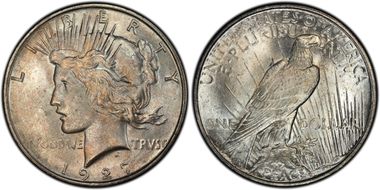


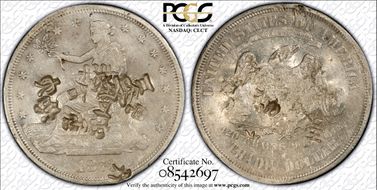
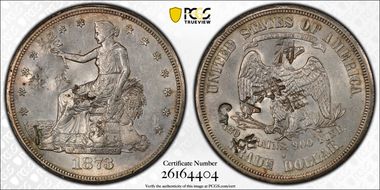








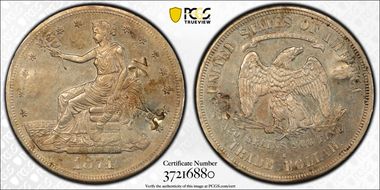















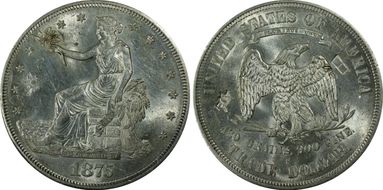





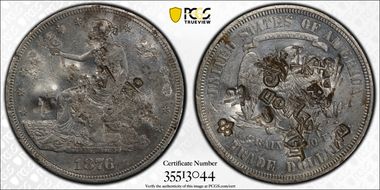


_album.jpg)





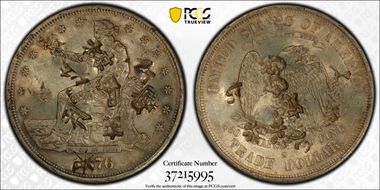








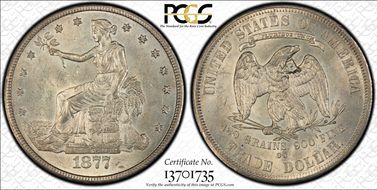

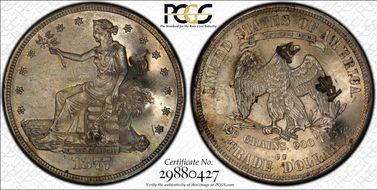





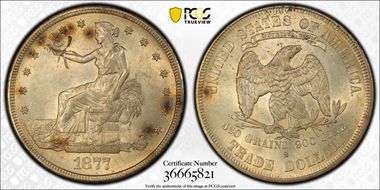






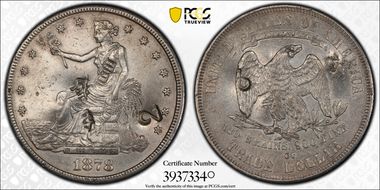















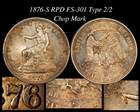
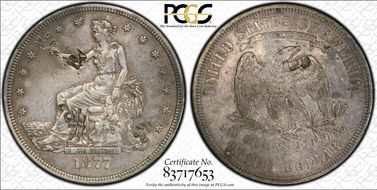

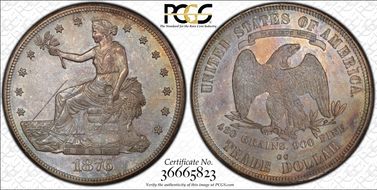
_album.jpg)
_album.jpg)